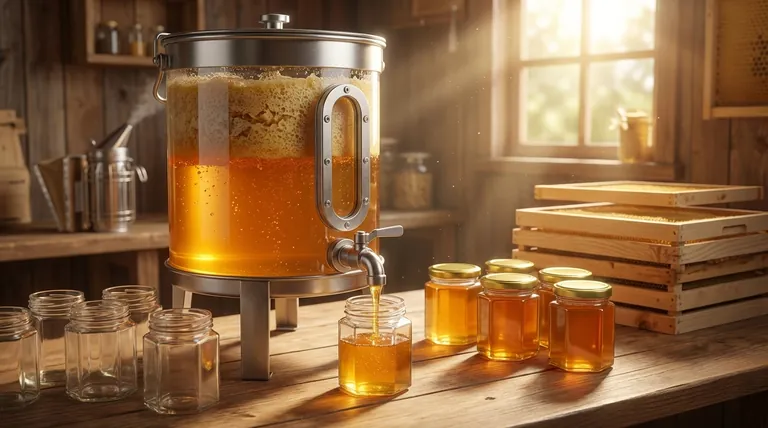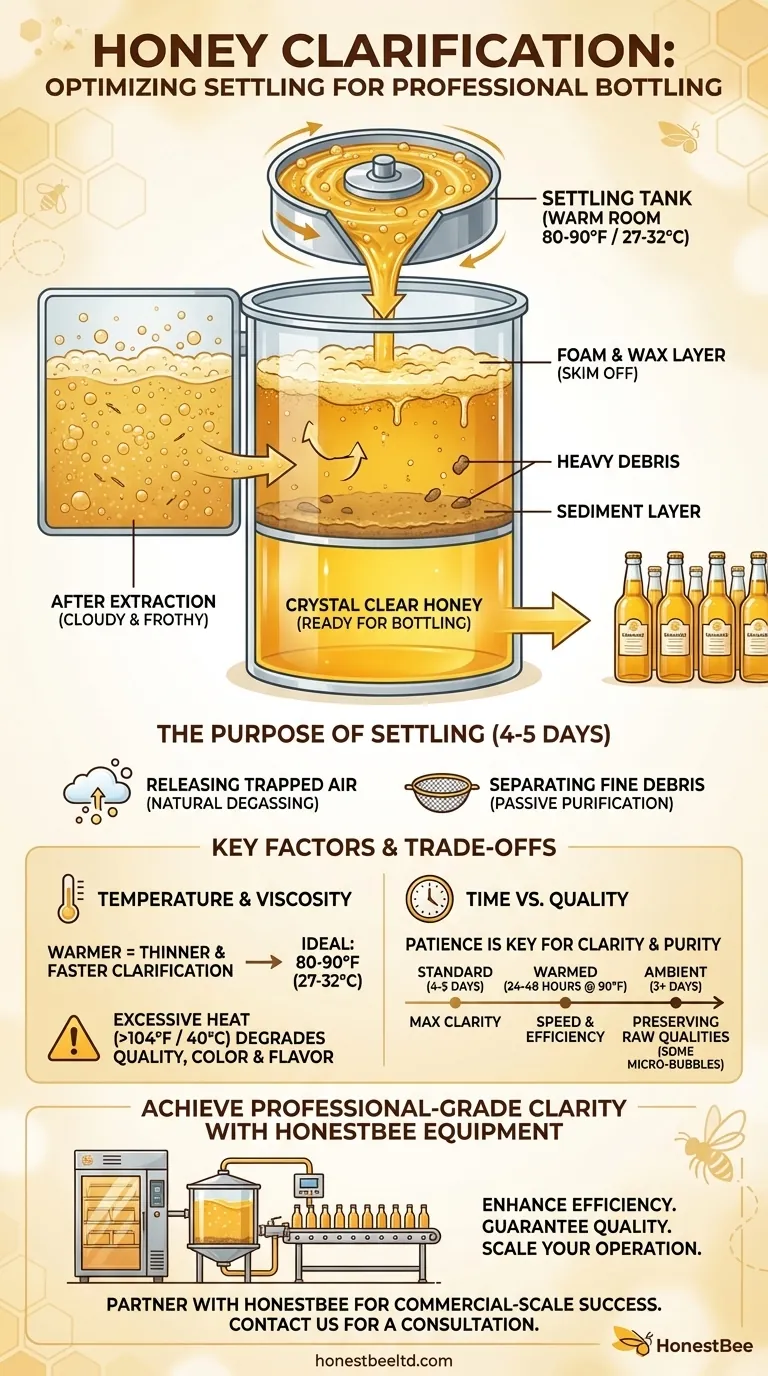As a general rule, you should let your extracted honey sit and settle for 4 to 5 days before bottling. This waiting period, known as clarification, is a critical step that allows trapped air bubbles and fine particulates to separate from the liquid honey, resulting in a clearer, more stable final product.
The time between extraction and bottling is not just a delay; it is an essential quality control process. Patience during this stage directly translates to the clarity, purity, and professional appearance of your bottled honey.

The Purpose of Settling Honey
After honey is removed from the comb using a centrifugal extractor, it contains more than just pure honey. The settling process is designed to passively purify the honey before it goes into its final container.
Releasing Trapped Air
The primary reason for settling is to allow microscopic air bubbles to escape. The rapid spinning of the extractor whips a significant amount of air into the honey, making it appear cloudy or frothy.
Because honey is so viscous, these tiny bubbles take a considerable amount of time to rise to the surface. Allowing the honey to rest undisturbed is the most effective way to let it naturally degas.
Separating Fine Debris
Settling also allows fine debris to separate. Small particles of beeswax, pollen, and other hive material that passed through the initial filters will either rise to the top with the foam or sink to the bottom of your settling tank.
This separation ensures the honey you bottle from the middle of the tank is as clean as possible. Once settling is complete, a layer of foamy wax will be visible on the surface, which must be skimmed off before you begin bottling.
The Critical Role of Temperature
The viscosity of honey is highly dependent on temperature. Warmer honey is thinner and less resistant to flow, which dramatically speeds up the clarification process.
Ideally, your settling tank should be kept in a warm room, around 80-90°F (27-32°C). At this temperature, bubbles and debris will separate much more quickly, sometimes reducing the settling time to just 2-3 days. Cooler temperatures will significantly extend the time required.
Understanding the Trade-offs
While the goal is clear honey, the method you choose involves balancing time, temperature, and effort.
Time vs. Heat
You can either wait longer at room temperature or gently heat the honey to speed things up. However, excessive heat is the enemy of quality honey.
Heating honey above 104°F (40°C) can begin to degrade its natural enzymes and beneficial properties, and can also darken its color and alter its delicate flavor. If you choose to warm your honey, use a controlled method like a heated bottling tank or a warming cabinet, and never apply direct, high heat.
Honey Viscosity
Not all honey is created equal. The nectar source directly impacts viscosity. A thin, runny honey like Alfalfa or Clover will clarify much faster than a thick, dense honey like Heather or Manuka.
You may need to adjust your settling time based on the specific type of honey you have harvested. A visual inspection is your best guide; bottle when the main body of the honey appears crystal clear.
A Practical Timeline for Bottling
Use your primary goal to determine the best approach for your harvest.
- If your primary focus is maximum clarity: Let the honey settle for the full 4-5 days in a warm room and carefully skim all foam from the surface before bottling.
- If your primary focus is speed and efficiency: Gently warm your honey in a dedicated bottling tank to 90°F (32°C), which can reduce the settling time to 24-48 hours.
- If your primary focus is preserving raw qualities: Settle at ambient room temperature for at least 3 days, accepting that some micro-bubbles may remain for a more "natural" look.
Ultimately, allowing your honey the time it needs to settle is the final step in honoring the work of your bees and producing a truly exceptional product.
Summary Table:
| Factor | Recommendation | Key Consideration |
|---|---|---|
| Standard Settling Time | 4-5 days | Allows air bubbles and fine debris to separate naturally. |
| Ideal Temperature | 80-90°F (27-32°C) | Warmer honey clarifies faster without quality degradation. |
| Primary Goal | Recommended Approach | Outcome |
| Maximum Clarity | Settle 4-5 days in warm room, then skim foam. | Crystal clear, professional-grade honey. |
| Speed & Efficiency | Gently warm to 90°F (32°C) in bottling tank. | Settling time reduced to 24-48 hours. |
| Preserving Raw Qualities | Settle at ambient temperature for 3+ days. | More natural look, some micro-bubbles may remain. |
Achieve Professional-Grade Honey Clarity with the Right Equipment
Producing crystal-clear, stable honey that meets commercial standards requires precision and the right tools. The settling process is just one part of a larger workflow that demands reliable, high-quality beekeeping supplies.
HONESTBEE is your trusted partner for commercial-scale beekeeping success. We supply durable, efficient equipment—from settling tanks and warming cabinets to bottling lines—designed specifically for the needs of commercial apiaries and beekeeping equipment distributors.
Partner with HONESTBEE to:
- Enhance Efficiency: Our equipment is engineered to streamline your post-harvest process, saving you time and labor.
- Guarantee Quality: Ensure the purity and brilliant clarity of every batch with tools that protect honey's natural qualities.
- Scale Your Operation: Access wholesale-focused solutions that help you grow your business reliably.
Ready to optimize your honey production from extraction to bottling? Let's discuss how our products can integrate into your operation.
Contact HONESTBEE today for a consultation and let us help you bottle perfection.
Visual Guide

Related Products
- Hexagonal Glass Honey Jars with Metal Lug Caps Elegant Versatile Packaging
- Classic Drum Shaped Glass Honey Jar with Airtight Lid
- Inverted Squeezable Honey Jar with No Drip Flip Top Cap for Easy Pouring
- Premium Heat-Resistant Glass Honey Dipper
- Premium Diamond-Faceted Glass Honey Dispenser
People Also Ask
- What is the best way to jar honey? Preserve Quality with the Right Container
- How many jars of honey do you get from a hive? Unlock Sustainable Harvesting Secrets
- What is done with the honey after extraction and filtering? From Purification to Perfect Packaging
- Why is a glass jar preferred for packaging honey? Ultimate Protection for Purity & Flavor
- What makes raw honey more aesthetically appealing than processed honey? Discover the Beauty of Authenticity



















